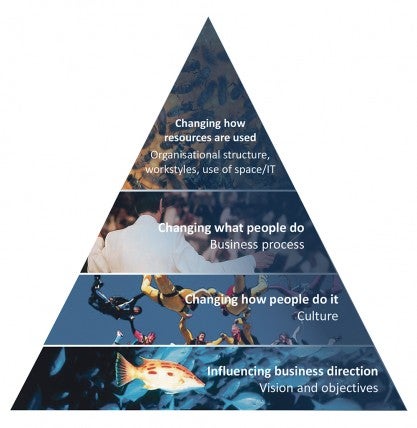Competition drives businesses to improve quality and speed to market, while reducing costs. Recent years of austerity have seen two evolutions of focus, the first-generation approach being getting fitter through cost reduction, largely through headcount reduction and tackling expenses. Once envisioned savings had been largely realised, many businesses moved to the second-generation approach of getting smarter, becoming more agile, doing more with less, and improvements through staff and industry engagement.
The benefits obtainable by getting fitter and getting smarter have now been largely realised albeit, in some cases, not to the extent expected.
Business A cut their innovation R&D programmes, then lost market share to competitors with stronger products. Company B made staff use annual leave, reducing morale and performance. Business C stopped colour printing for deal books, and deal-closing dinners, impacting client relationships and return business.
Furthermore, first and second-generation efforts can leave businesses poorly prepared to return to growth. Recruitment firms are reporting a growing level of demand, but many firms have frozen or reduced salaries. In a recovering market, many staff will look to move elsewhere, resulting in recruitment costs, and the loss of knowledge and client relationships.
SHIFTING THE CONVERSATION
It’s time to recognise the limitations of the first and second-generation approach, and expand to how the business operates, its culture and purpose. A third-generation approach, becoming strategic, shifts the focus to driving value, getting to root causes of inefficiency and providing integrated, business-wide solutions.
The difference is marked – for example, for many, workplace agility has resulted in a reduction in real-estate costs and improved collaborative working. However, focusing on only real estate and working styles can neglect wider changes needed to gain full value.
Becoming strategic involves whole-system thinking, underpinned by robust diagnostics to find the true problem
Company D had not seen the productivity gains promised by greater collaboration. But their objectives included rewarding high-performing staff, manifesting in a blame culture as individuals sought to protect their position, with communication occurring via e-mail to create an audit trail – limiting the impact of reducing physical barriers in the workplace. Business E provided new tablets to staff to encourage innovation, but conflicting objectives created confused messages – positive communication on the new tools alongside monthly “shame” reports on bills and stringent rules. Accordingly, tablet usage was mixed and benefits limited.
INCREASING VALUE
Third-generation companies create a route to senior leaders to present the case for a more strategic approach – linked to business goals and backed by diagnosis to understand root causes. Solutions are delivered by integrated teams with a thorough understanding of the business and a range of technical expertise, including processes and behaviours.
Business F started with a pilot, triggered by the challenge of delivering a step-change in a particular product. The transformation team, led by the owner business and staffed with secondees from HR and ICT, delivered a model spanning organisational design, ways of working and processes, workplace, and IT. The new product was delivered faster and cheaper, through increased informal collaboration, quicker information-sharing and decision-making, and failing smarter and faster.
Becoming strategic involves whole-system thinking, underpinned by robust diagnostics to find the true problem, delivered through integrated teams that address people, processes, space and technology. First and second-generation efforts can improve the performance of a business’s component parts, but only third-generation efforts can address the sum of the parts.
SHIFTING THE CONVERSATION

